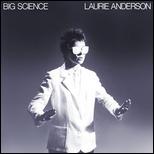
Laurie Anderson "Big Science"
 Laurie Anderson "Big Science" (Warner Bros, 1982) Artist: Laurie Anderson Album: "Big Science" Release Date: 1982 Label: Warner Bros. Genre: Experimental, Performance-Art, Art-Rock, Spoken-Word, Avant-Garde Mood: Theatrical, Ironic, Sophisticated, Clinical Reminds Of: Kraftwerk, Lydia Lunch, Brian Eno What People Think: PitchforkMedia, AllMusicGuide Definitely Worth Buying: CdUniverse, Amazon Tracklist 1. From The Air 2. Big Science 3. Sweaters 4. Walking & Falling 5. Born, Never Asked 6. O Superman (For Massenet) 7. Example #22 8. Let X=X 9. It Tango From perhaps 1977-1984, music had a preoccupation with the progress of society and technology and George Orwell was to blame. 1984 created an unconscious cultural deadline for the self-examination of Western society. Rock music sang about the spawning of mega-governments, punks assaulted fascism, pop stars noted a scaled cooling of compassion, jazz captured the spirit of robots. Suddenly, the word “modern” became an esteemed concept. It instructed us to accept the reality of imminent nuclear war, to be gaudy, to indulge, to ditch your 8-track player and buy a Betamax, to compete for every decibel of laughter, scrap of land, and shade of color.On Big Science instead of fostering these notions, Laurie Anderson observes them. Culled from fragments of her performance art opus, United States, Live, the songs from Big Science are compassionate and alarming. They describe the death musings of a commercial airline pilot over an intercom (“From the Sky”), the hubris of urban expansion (“Big Science”), the ignorance of the free-born (“Born, Never Asked”). The minimal music is loyal to her themes, melding organic brass and woodwinds with electronic beats, vibes, and melodic interludes. Most of the songs find Anderson, speaking over the music with her compelling pace and diction. “Cause I can see the future and it’s a place - about 70 miles east of here,” she utters in the simple, Cartesian, “Let X=X.” In this essence lies the source of Big Science’s magnificence. Here silence is used as artfully as words. There are empty slabs of pause, appealing to mechanistic processing and as well as warm-hearted salutations. The renowned “Oh Superman”, the album’s centerpiece, is complete immersion in this notion. Anderson reads her apocalyptic verse while a robot voice echoes. This interplay is chilling: like a mental duel between compassion and complete detachment. The “song” finds Anderson talking on the phone to what seems at first to be her mother then she gives pause, “OK who is this really?” And the haunting reply comes, slow over a subtle, sweet keyboard dirge, “I am the hand, the hand that takes.”The world Anderson describes, however, is far from minimal or bleak, for she also gives us texture. “Example #22” erupts with rhythm and jovial horns. German samples abound with Anderson bleating,“Honey you’re my one and only, So pay me what you owe me.” A bass and kick drum join the fray and suddenly the modern world is dancing. “It Tanga” jests at the connection gaps between men and women, women speaking open-ended and men repeating ageless Dylan, “Isn’t it just like a woman.” And that’s how the sparse chaos that’s presented by Big Science ends. You’ve been lured into a dream without realizing. Anderson has assaulted you with enough thought and silence and sound that you return society more enlightened but less certain of anything than when you left.As “O Superman” climaxes, Anderson reaches a resolution to this societal fray and I can’t help but think that Orwell would approve. It unfolds gradually in the telling, “Cause when love is gone, there’s always justice. And when justice is gone, there’s always force. And when force is gone, there’s always Mom. Hi Mom” It’s a poignant conclusion for certain, but when living in a world of compromise and miscommunication, it may be the best of all things. "This is the time, and this is the record of the time..." Link |









 Join the Blue Ribbon Online Free Speech Campaign!
Join the Blue Ribbon Online Free Speech Campaign!





